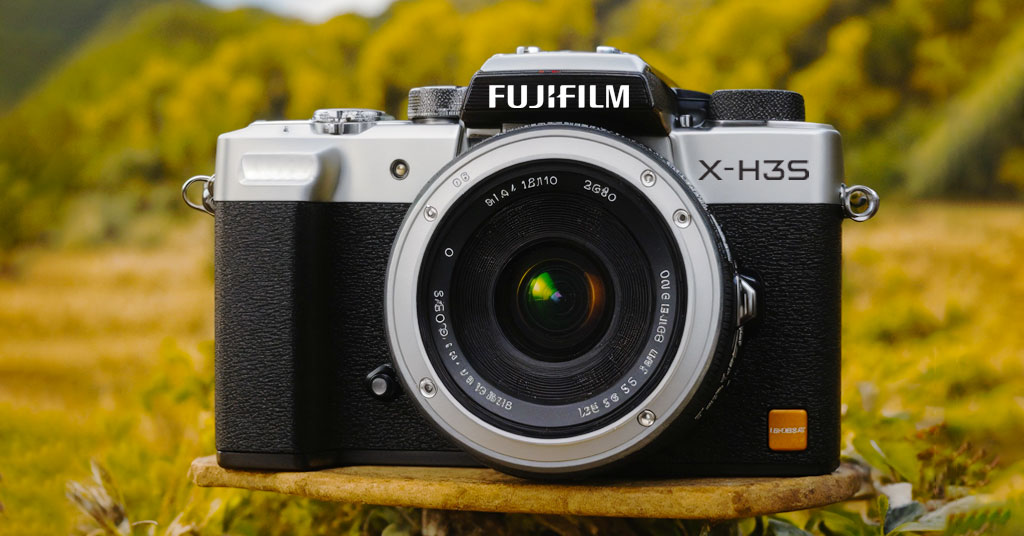Fujifilm fans are eagerly waiting for the launch of the X-H3S. This camera is expected to take the high-speed mirrorless game to the next level. It will likely continue the tradition set by the X-H2S but with several important upgrades.
The X-H2S made waves when it was released. It offered impressive speed, strong video features, and excellent image quality. The X-H3S is now expected to build on that success with better performance and more advanced technology.
In this article, we will look at what the Fujifilm X-H3S might offer. We will explore the possible specs, compare it with the X-H2S, and see how it could stand against top competitors like the Sony A9 III, Canon EOS R3, and Nikon Z9. Let’s dive into what we know so far—and what we hope to see.
Today’s Best DJI Avata 2 Amazon Deal

Mason knows photography inside and out. With 15 years of hands-on experience, he’s written about cameras, lenses, and gear of all kinds. He even spent five years as a journalist, diving deep into music and writing sharp, engaging stories. Now, Mason shares his photography knowledge, helping readers find the right gear and perfect their skills. He’s also proud of his unbeatable Wordle streak!
Predicted Features of the Fujifilm X-H3S
Sensor & Image Quality
The Fujifilm X-H3S is rumored to include a stacked CMOS sensor. This kind of sensor is known for faster data processing. It may allow quicker readouts, lower rolling shutter effects, and better image quality in difficult lighting.
Compared to the X-H2S, the X-H3S could bring noticeable improvements. The X-H2S already had a fast sensor, but the new one might deliver better low-light shots and smoother color transitions. Photographers may see cleaner shadows and more detail in highlights. This will help in capturing scenes with a lot of contrast.
If the X-H3S includes these upgrades, it would be a great tool for both photographers and videographers. People who shoot weddings, events, and travel photography would benefit from sharper images and richer colors. In tough lighting conditions—like concerts or golden hour shoots—the X-H3S might deliver results with less noise and more dynamic range.
Autofocus and AI Enhancements
Autofocus has become a key selling point for cameras. For the X-H3S, Fujifilm is expected to introduce better phase detection and faster subject tracking. This means the camera could lock on to subjects more quickly and stay focused as they move.
Fujifilm may also add advanced AI tools. These could help the camera recognize different subjects like animals, cars, or people more accurately. The AI could adjust focus in real-time, keeping moving subjects sharp even when the scene gets busy.
This would be a huge plus for sports and wildlife photographers. Fast-moving subjects, like birds in flight or athletes in motion, are hard to track. A smarter autofocus system would allow photographers to focus more on composition and timing, and less on manually adjusting focus. Content creators shooting video would also benefit, as smooth and reliable focus makes footage look much more professional.
Burst Rate and Speed
Speed is one of the biggest reasons to choose a camera like the X-H3S. The new model is expected to offer burst shooting at over 20 frames per second. This would make it one of the fastest cameras in the mirrorless world.
With this kind of performance, users can capture key moments that last only a split second. This is especially useful in sports, wildlife, or street photography. A fast burst rate also helps when you want to select the perfect frame from a series of quick movements.
If Fujifilm improves the buffer and processing speed, the X-H3S could also clear images faster. This means less waiting between shots and better support for RAW files. For professionals who often shoot in bursts, this could be a game-changer.
Video Capabilities
The X-H3S is expected to raise the bar in video. Rumors suggest it could shoot 6K video at high frame rates. It might also support internal 10-bit 4:2:2 recording. This level of quality is excellent for color grading and post-production work.
These video specs would put the X-H3S ahead of many rivals in its class. While the X-H2S already offered solid video features, the X-H3S might go even further, giving creators more control and flexibility. Smooth 6K footage with rich color depth would be perfect for documentary work, YouTube content, or even indie films.
For creators who want to produce professional-level video without carrying a big cinema camera, the X-H3S could be the perfect fit.
Build and Ergonomics
Fujifilm may also make design upgrades with the X-H3S. A more durable body, better grip, and stronger weather sealing are expected. These improvements would make it easier to use the camera in rain, dust, or cold.
Better ergonomics also mean a more enjoyable shooting experience. A deep grip and well-placed buttons allow for easier control, especially when using heavy lenses. These features matter when you are out shooting all day or working in rough environments.
Photographers who work outdoors—such as nature, travel, or adventure photographers—will appreciate a camera that feels solid and stays reliable in all weather.
Fujifilm X-H3S vs X-H2S: What’s Different?
The X-H3S will likely bring several upgrades over the X-H2S. The most talked-about change is the new sensor. If Fujifilm goes with a stacked CMOS sensor, it could improve speed and image quality at the same time. This would offer better results in both photo and video modes.
Autofocus is another area that may see big changes. While the X-H2S already had strong autofocus, the X-H3S could bring faster and more accurate tracking. AI tools may also help in recognizing subjects in tricky scenes.
Video features are expected to improve as well. While the X-H2S could shoot 6.2K at 30 frames per second, the X-H3S might allow higher frame rates with better internal recording options. This could attract filmmakers who want top performance without extra gear.
Speed will also likely improve. A faster burst rate and improved processing might help professionals capture action with less lag. The buffer size could also be bigger, helping with long shooting bursts.
Overall, the X-H3S looks like a more advanced tool for serious users. It may still share the strong build and layout of the X-H2S, but the upgrades inside could make a big difference for fast-paced photography and video work.
Competitors in the High-Speed Mirrorless Market
Sony A9 III
The Sony A9 III is known for its blazing speed and smart autofocus. It uses a global shutter, allowing flash sync at any speed and no rolling shutter effects. It is a favorite among sports and news photographers.
The X-H3S may not match the A9 III’s global shutter, but it could come close in speed and focus tracking. Fujifilm’s color science and user-friendly controls might give it an edge for users who care about style and ease of use.
Canon EOS R3
The Canon EOS R3 is another top choice for high-speed photography. It features fast autofocus, great low-light performance, and strong video options. Canon also has deep lens support, which helps professionals.
The X-H3S might not have as many lenses available, but it could win in size and value. If the autofocus and video upgrades are as strong as rumored, Fujifilm could offer a lighter and cheaper option for those who want similar power.
Nikon Z9
Nikon’s Z9 is a flagship model. It offers speed, strong autofocus, and amazing image quality. It is big, powerful, and built for demanding work.
The Fujifilm X-H3S might appeal to those who want similar results in a smaller, more affordable body. While it may not beat the Z9 in every area, it could match it in burst rate and autofocus precision.
For photographers who want fast action shots and great video but don’t need a full-frame system, the X-H3S could be a smart alternative.
Release Date & Price Speculation
As of now, Fujifilm has not given an official release date for the X-H3S. However, many expect the camera to arrive in late 2025 or early 2026. This timing would make sense, following Fujifilm’s usual product cycle.
In terms of price, the X-H3S will likely be in the high-end mirrorless range. It may be slightly more expensive than the X-H2S, due to the rumored new sensor and video upgrades. A price tag between 2,500 and 3,000 United States dollars seems likely.
Fujifilm may try to strike a balance between performance and value. By offering top-tier features in an APS-C body, the company could attract professionals who want speed and quality without moving to heavier, full-frame systems.
The X-H3S could be a smart buy for users who want high-end features but do not need the size and cost of full-frame competitors.
What Photographers and Videographers Want from the X-H3S
The photography community has high hopes for the X-H3S. Many users want better autofocus. They hope the camera will be faster and more reliable in tracking moving subjects. Improved eye detection and smarter AI subject tracking are on the wish list.
Another top request is higher burst rates. Sports and wildlife shooters want to capture fast action without missing key moments. A faster frame rate with a big buffer would help a lot.
Video creators are asking for 6K video, better codecs, and more bit depth. Many want 10-bit 4:2:2 internal recording to make editing and color grading easier. Longer recording times and less overheating are also common requests.
Battery life is another key point. Professionals want a camera that can last all day on a single charge. Fujifilm’s current batteries are decent, but more power would be welcome.
Overall, users want a camera that is fast, smart, and reliable. They want it to work well in both photo and video, without needing extra gear. If the X-H3S delivers on these points, it will be a huge success.
What are the key features of the Fujifilm X-H3S?
When will the Fujifilm X-H3S be released?
How is the Fujifilm X-H3S different from the X-H2S?
Who will benefit most from the Fujifilm X-H3S?
How does the X-H3S stack up against cameras like the Sony A9 III, Canon EOS R3, and Nikon Z9?
Final Thoughts: Will the X-H3S Live Up to Expectations?
The Fujifilm X-H3S is shaping up to be a powerful tool. With a new sensor, faster autofocus, better video, and smart design upgrades, it could raise the bar in the mirrorless market.
This camera will likely appeal to professionals and serious enthusiasts. Whether you shoot sports, wildlife, or cinematic video, the X-H3S could offer the speed and image quality you need. It combines Fujifilm’s trusted design with modern tech.
If the rumors are true, the X-H3S might even compete with some full-frame models. It offers a great mix of performance, size, and price. As we wait for more details, the excitement around the X-H3S continues to grow. Stay informed as more news about the Fujifilm X-H3S rolls out. Subscribe to our newsletter to get the latest updates, rumors, and expert opinions straight to your inbox.
We’d love to hear your thoughts. What features are you most excited to see in the X-H3S? What do you hope Fujifilm will improve compared to the X-H2S? Join the conversation in the comments below.


